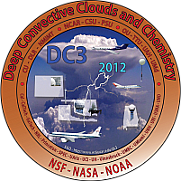DC3
Deep Convective Clouds & Chemistry Project
PROJECT DATES
05/01/2012 - 06/30/2012
Project Location
Salina, Kansas
PROJECT DESCRIPTION

The Deep Convective Clouds and Chemistry Project (DC3) field campaign investigated the impact of deep, midlatitude continental convective clouds, including their dynamical, physical, and lightning processes, on upper tropospheric (UT) composition and chemistry.
The DC3 field campaign made use of extensively instrumented aircraft platforms and ground-based observations. The NSF/NCAR Gulfstream-V (GV) aircraft was the primary platform to study the high altitude outflow of the storms, and was instrumented to measure a variety of gas-phase species, radiation, and cloud particle characteristics. In addition, the DLR Falcon 20 supported the GV with measurements of trace species in the fresh anvil outflow.
The GV and Falcon were also documenting the downwind chemical evolution of the convective plume. The NASA DC-8 aircraft complemented the GV and Falcon with in situ observations to characterize the convective storm inflow and provided remote sensing to aid in flight planning and column characterization. Ground-based radar networks were used to depict the physical and kinematic characteristics of the storm and provided input to the aircraft operations. The impact of lightning on outflow composition was constrained through detailed measurements from lightning mapping arrays. The forecasting and analysis was improved through other observations such as radiosondes.
The observations were conducted in three locations:
- northeastern Colorado,
- west Texas to central Oklahoma, and
- northern Alabama in order to gather data on different types of storms and with different boundary layer compositions as well as to ensure sampling of convection during the time period of the field campaign. The types of storms sampled were air mass, multicell, and supercell convection.
Scientific Objectives
The DC3 project addressed the following goals:
- Quantify and characterize the convective transport of fresh emissions and water to the upper troposphere within the first few hours of active convection, investigating storm dynamics and physics, lightning and its production of nitrogen oxides, cloud hydrometeor effects on wet deposition of species, surface emission variability, and chemistry in the anvil.
- Quantify the changes in chemistry and composition in the upper troposphere after active convection, focusing on 12-48 hours after convection and the seasonal transition of the chemical composition of the UT.
Thunderstorms Affect Air Pollution :: Video by InsideScienceTV
Education and Outreach
![]() The DC3 project provided broader impacts to society via extensive education and outreach activities, and via improved understanding of sources of UT ozone, an important constituent to climate and air quality, for assessment reports and resulting policy implications. Further, DC3 measurements are instrumental in improving model parameterizations of convective transport, production of NO by lightning, and wet deposition of chemical species.
The DC3 project provided broader impacts to society via extensive education and outreach activities, and via improved understanding of sources of UT ozone, an important constituent to climate and air quality, for assessment reports and resulting policy implications. Further, DC3 measurements are instrumental in improving model parameterizations of convective transport, production of NO by lightning, and wet deposition of chemical species.
All photos copyright University Corporation for Atmospheric Research.
CONTACT INFORMATION
Principal Investigators:
- Mary Barth NCAR/ACD
- Chris Cantrell
Project Manager:
- Vidal Salazar NCAR/EOL
- Allen Schanot NCAR/EOL/RAF
Data Manager:
- EOL Archive NCAR/EOL/DMS
